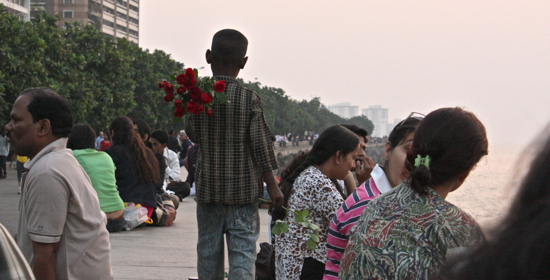The Indian Drifter: A common feature of the urban Indian landscape, the Drifter is someone who is simply hanging around, doing nothing apart from wandering idly from one place to the next. Predominantly male, the Indian Drifter is easy to spot: standing listlessly on the street-side, squatting in front of a shop, installed next to a street peddler, snoozing in a park – you get the idea. The Indian Drifter is not to be confused with the homeless: he does not carry with him all his belongings, and gives the impression of someone ready to move on, quite unlike the homeless we see lodged permanently on the footpaths and subways in the West.
Drifters, through interesting in their own way, do not offer much variety to an observer – you tire of watching them after a while. But their counterparts on the street, the Workers, are a more interesting bunch. We saw a lot of them during our recent India trip; I’ve put some of them together in an album: Indians at work.
There are 23 of them in all (though the last picture, taken by Wife, is a bit of a joker in the pack), including some rarely-seen vocations like selling drums or riding an elephant. The collection isn’t a statistically significant sample, nevertheless it’s fun to look at this set and identify patterns or find individual quirks. Here are some observations:
- All of them are male.
- They are all young: judging from their faces, none of them appear above 50. Roughly 15 of the 22 seem below thirty. One is a small boy, and there are a couple of teenagers.
- Nine are self-employed (or are engaged in an independent “business”), 13 work for someone else (Seven of these wear uniforms).
- Five are stationary (customers go to them), 17 are on the move (either they go to the customers, or their vocation involves constant movement).
- 12 offer their services directly to their customers, 10 are somewhere in the middle of the chain.
- The split between the clean-shaven and the mustachioed is even.
These dimensions can be explored further, beyond the photographs. For instance, how much does each earn? Does the taxi driver earn more than the elephant rider? Does the cowherd make more money more than the fisherman? Are you better off selling magazines on the street or snacks in a railway station? Common sense may be misleading in getting to these answers – we can surely expect some surprises there. And then: how long have they been in the profession? The skilled ones – like cooking, drawing, fishing – would see a longer retention; some others like selling chat or magazines are probably temporary affairs, one in a sequence of occupations these people try their luck in.
The images present a vibrant side of India, one engaged in industry. (Ignore, for a moment, the taxi-driver taking a nap.) They also show, in a limited setting and scale, India’s entrepreneurial side, one where individuals with a little money invest it into an independent venture with the hope of making it big. The Workers, in choosing to struggle in their own ways, are an inspiration to the Drifters.

I identified with so many things on your blog. keep up the good work. 🙂
You have a lovely website, Soo – so same to you!
on my recent india trip, i took a photo that focussed on the ‘live dosa counter’ (photo 16) – it drew some laughs on facebook.
– s.b.
How do people laugh on Facebook? I thought you could only Poke, or Like?!
like this –> “LOL” 😉
– s.b.
I beg to differ. A skilled chaatwalla is not in a temporary affair.
Signed,
Street Food is My Mantra.
That’s your hope speaking, Kushal. But as long as the street-food vendors have such devoted fans, they have nothing to fear.
Very interesting post. Loved the pictures, especially the one with the off-duty cop. Very Cool 🙂 And there is a hat seller too right next to the magazine vendor, one more to the count.
And so much information gleaned from the pics – didn’t know that was even possible!
Sid, I thought that hat seller was actually selling magazines! But you are right, the artifact is a folded hat – excellent observation.
The off-duty cop was a real shocker – I thought one saw such things only in Iraq and Afghanistan.
agree with buns….apart from food (irrplaceable), i think they are just everywhere!
but if i try and look at the brighter side, so many people are employed…something which the indian govt finds tough to deal with
bips
Ok, I accept defeat – the chatwallahs are indeed permanent fixtures. They have to be, else where would you and Buns go?!
Very interesting observation. I love the idea to have that alive and ticking dosa counter at B’lore airport btw. It’s a boon for mums struck by flight delays. Compared to the dosa ka ‘seedha prasaran’ the rest of the food is strictly ‘highlights.’ 🙂
I can’t believe this blog is turning into a discussion forum for food related topics. I’m going to ban all such comments now – or direct them to colours’s blog.
The saddest part is that Dosa Counter is there only for the domestic flights. If you are in International gates, you just look through the glass partition greedily at the Dosa Counter.
A good reason to stay put in India and not indulge in International travel.
I am glad we finally agree about staying put in India due to food related reasons.
Hi, lovely photos. We would love to showcase them for our magazine. Can you get in touch with me? Cheers.